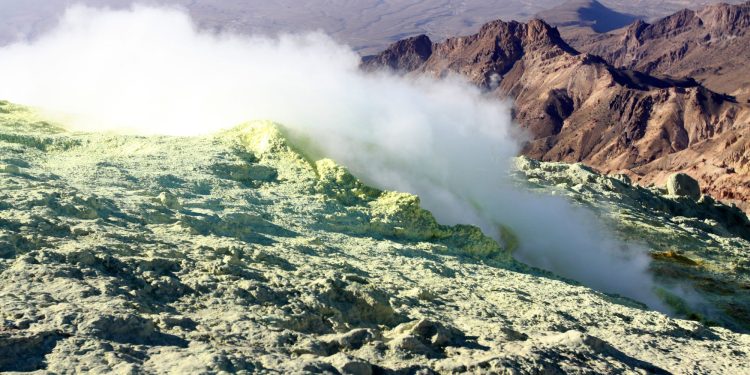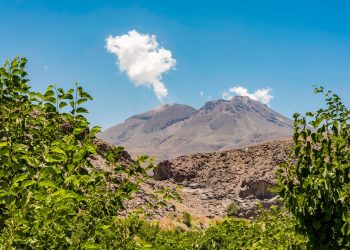For decades, the colossal Taftan volcano in eastern Iran appeared like a lifeless piece of history. It rose almost 13,000 feet above the desert landscape, proud and still. But in 2023, something remarkable happened: its peak began to rise. Within ten months, satellite images showed that the peak had risen about 3.5 inches and has not returned since.
Scientists say this bulge, observed from July 2023 to May 2024, is a clear sign that Taftan is not after all extinct. He might even be about to catch his breath.
A subtle signal from the depths
This discovery was reported by a team led by volcanologist Pablo González from the Spanish Institute of Natural Products and Agrobiology (IPNA-CSIC). Using data from the European Space Agency’s Sentinel-1 satellite, González and doctoral student Mohammadhossein Mohammadnia spotted the slow rise, a change subtle enough to go unnoticed by the naked eye, but powerful enough to alter the volcano’s summit.
Their study, published in Geophysical Research Letters, found that the movement was not due to precipitation or earthquakes. Instead, the movement originated from deep within the volcano, somewhere between 1,600 and 2,000 feet below the summit. This is where hot gases and fluids apparently create pressure within the volcano’s hydrothermal system, or perhaps a small bubble of magma has migrated upward.
“He’ll have to let it out one day, either explosively or silently,” González said in an interview with Live Science. He stressed that there was no indication of an imminent eruption, but that Taftan needed more attention.
The volcano that wouldn’t sleep
Volcanoes are considered extinct if they did not erupt during the Holocene, or the last 11,700 years. Taftan was once considered to fall into this category, its last recorded eruption being over 700,000 years ago. But new signs suggest otherwise.
People began to experience sulfurous odors and a haze of smoke rising from the crater since 2023. The smell of gas was reported to be so strong that it reached the town of Khash, located about 50 kilometers away. These events prompted researchers to review satellite images and confirm ground deformation.
The summit of Taftan is punctuated by fumaroles, vents of gas releasing substances such as water vapor, carbon dioxide, sulfur dioxide and hydrogen sulfide. The team recorded a sulfur dioxide release of around 20 tonnes per day during the uplift phase, a remarkable increase that indicates higher underground pressure. Two additional intense gas explosions on May 16 and 28, 2024 suggest further augmentation of the volcano’s internal plumbing system.
Capturing the secret movement of the ground
High-precision monitoring of such slow and small movements requires high precision. The scientists used a new analytical approach called a common mode filter, canceling out noise in the atmosphere to provide clearer satellite readings. Using this technique on Sentinel-1 radar data, they were able to detect surface movements of a few millimeters.
For more than ten months, the ground directly beneath Taftan’s summit bulged upward while the sides tilted slightly outward, typical behavior for the injection of hot gas or fluid below. What is unusual about this finding is that the increase has not abated. Although such episodes persist for only a brief period and subside within a few weeks, it continues without respite, implying sustained pressure.
Previous research employing similar techniques also observed an ephemeral bulge at the summit of Taftan years ago, a phenomenon that grew about 4 centimeters high and lasted no more than a few weeks before dissipating. The newly developed sustained deformation indicates that the volcano’s underlying systems are in no way stable.
A living volcano above a moving Earth
Taftan sits at the top of the Makran subduction zone, where the Arabian plate slides beneath the Eurasian plate. This slow, grinding collision causes volcanism and earthquakes in Iran and southern Pakistan. The burial of oceanic crust allows the release of fluids that melt the mantle above, forming magma that fuels volcanoes like Taftan.
Even if the magma does not rise to the surface, the heat flow and movement of gases can reshape the landscape above. “Our results indicate that Taftan is more active than previously thought,” the study authors wrote. This event, they continue, calls into question the entire Makran volcanic arc, where other peaks could also be discreetly active.
A wake-up call for surveillance
Unlike the better-known American or Japanese volcanoes, Taftan does not have any ground monitoring equipment or an observatory. The region’s remoteness, mountainous landscape and security concerns make field work difficult. Satellite technology is therefore an extremely valuable resource.
“Satellite radar gives us eyes where it is too dangerous or out of range,” González said. By cross-referencing repeated photos from different orbits, scientists can see when the ground is moving up, down or tilting, often before they can see it with their eyes.
González made it clear that the goal was not to alarm local populations but to encourage investment in regional monitoring networks. “This study does not want to alarm the population,” he said. “It’s a wake-up call for local authorities to invest money in this exploration.”
Understanding the risks of Taftan
For now, Taftan does not pose an imminent threat, but its revival cannot be ruled out. If tensions continue to rise, the volcano could one day release this energy, perhaps in the form of minor steam-propelled explosions or larger explosions.
Local communities such as Khash in Iran and the Pakistan border town of Taftan may experience falling ash, poor air or contaminated water if this occurs. More explosive eruptions would endanger crops and buildings by lava flows or pyroclastics.
However, most scientists view today’s exercise as a salutary reminder that Earth’s systems are vital and constantly changing. A volcano can lie dormant for centuries, then growl quietly underground before anyone knows anything about it.
Practical implications of the research
Taftan’s results demonstrate the power of satellite radar for observing volcanoes around the world, particularly where there is little or no ground monitoring. Remote sensing can detect subtle ground movements well before they are apparent, providing advance warning of ground movement.
By making these methods more precise, scientists can make more accurate predictions of when volcanoes will wake up, which could save lives and property. The research also overturns long-held assumptions about extinct volcanoes. The gradual elevation of Taftan reminds us that “off” is not always synonymous with “sleeping”.
More broadly, the research enhances global efforts to map hidden geothermal systems, which could in the future be used to produce clean energy. Observing how fluids and heat move beneath the surface also improves understanding of earthquakes, mountain building, and the Earth’s inner workings.









